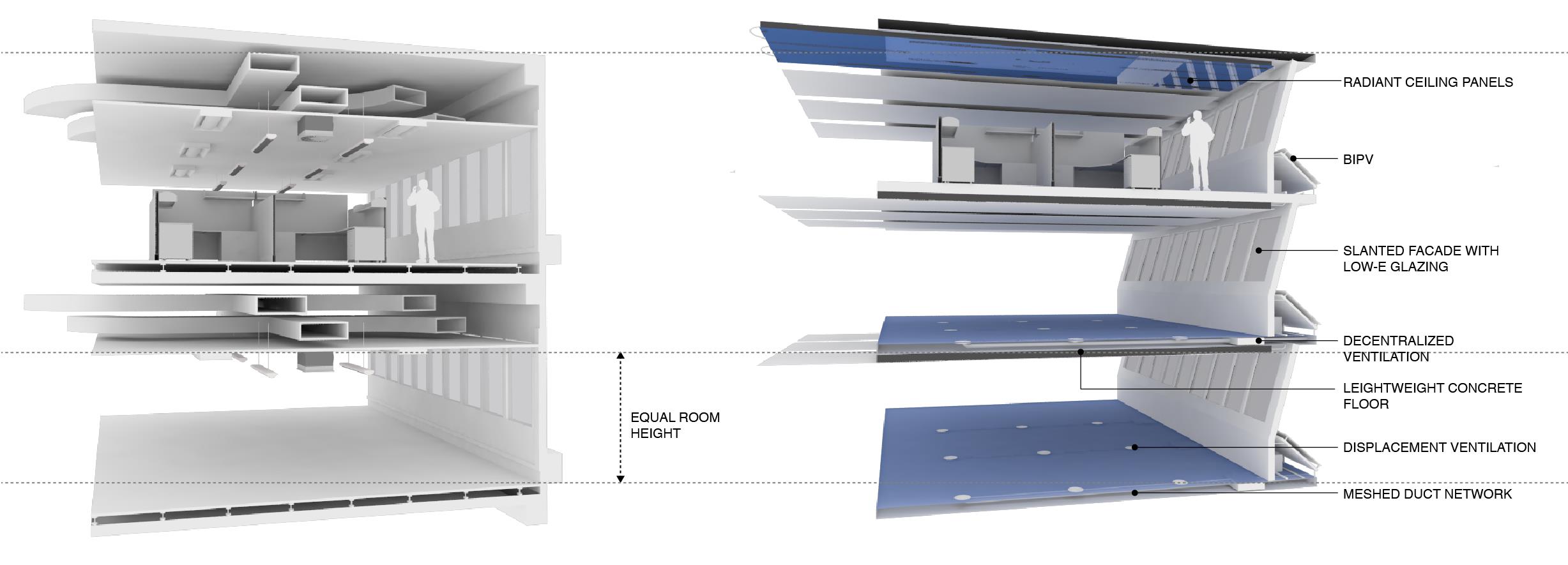What is the key to sustainable construction?
[Image: REUTERS/China Daily.]
The UN predicts that by 2050, 70% of the global population will live in cities. Cities are manifested by their buildings, and buildings are among the greatest contributors to greenhouse gas emissions. In Singapore, for example, buildings and households consume almost 50% of the electricity, causing a similarly large proportion of the country’s CO2 emissions.
Air conditioning, like the internet, has been called a 'transformative technology'. It has changed the places where we live and work – and the way we live and work. By conditioning the interior of a building, we are able to de-couple it from the outside climate, making it possible to live and work comfortably inside. The problem is that conditioning interior spaces requires a lot of energy. In Singapore, 70% of the energy used in buildings is used for cooling, dehumidification and ventilation.
The temperature and humidity of the indoor air and the temperature of the interior surfaces determine interior thermal comfort. Conventional air-conditioning uses large amounts of cold and dry air to achieve thermal comfort. The very low temperatures associated with this process (down to 6°C) are required for dehumidifying the air to reach a comfortable level of humidity.
To provide these low temperatures requires a large amount of energy. Additionally, air is not a very efficient heat transport medium. Therefore, large amounts of air need to be distributed throughout the building, requiring large ductwork systems to be routed vertically and horizontally. In Singapore, up to one third of the volume of a floor is needed for ductwork to distribute air. This means that a large fraction of a building is built not for its occupants, but to host the technical systems required for air conditioning.
In 2010, ETH Zurich started their research at the Singapore-ETH Centre (SEC) on more efficient ways of providing a comfortable indoor climate. At the Future Cities Lab Module 1, we explore new technical systems and their impact on building design, construction and occupant comfort.
We came equipped with our 'European' concepts of heating and cooling for moderate climates, well aware that the climatic context in Singapore is much more demanding and extreme. Whereas in our climate we are used to the oscillation of hot and cold, of dry and humid periods, the tropical climate in Singapore is constantly hot and humid, making this the 'worst-case scenario' for creating comfortable interior spaces.
The concept we have developed consists of three main components.
The first is the split between the cooling (sensible cooling) and dehumidifying (latent cooling). Instead of using cold and dry air for both, we distinguish between removing heat from the building interior and removing moisture from the air coming from outside. The benefit of this approach lies in the fact that the cooling process, which contributes to around 60% of the total cooling load, can be achieved using much higher temperatures (up to 18°C) than those required for dehumidifying; separating these functions thus lowers the amount of electricity required.
A prerequisite of this approach is to change the method by which the heat is removed from space. Conventional systems use so-called convective heat transfer as provided by circulating air. In our approach we focus on radiative heat transfer provided by large cold surfaces which allow cooling with much higher temperatures. The challenge using this technique, however, is to avoid condensation that might occur when large amounts of hot and humid air come into contact with the colder surfaces.
The second component is using water instead of air for heat transport. Water has a much greater heat-transporting capacity than air, which allows for much smaller pipes that can be easily integrated into the construction. Extensive false ceilings and floors to hide the technical systems become unnecessary and thus the volume can be saved.
The third component is using small, decentralised ventilation units instead of a central ventilation unit [1]. These small units transport the air required for indoor air quality through the facade, dehumidifying it in the process and blowing it into the room they are installed in. This makes air distribution throughout the building unnecessary, again saving space and volume. Moreover, the unit can be integrated into the facade or the floor, for example, to save even more space.
All three measures allow a much stronger interweaving of service systems with constructive elements, freeing up space and volume. They also bear interesting potential for different approaches to designing interior spaces and facades. As a result, it is possible to save up to one third of the volume of a typical Singaporean building floor.
Hence the project’s title '3-for-2' [2]: in the future, three floors could be built within the volume taken up by two floors of a conventional building.
[Illustration: SEC FCL / ETH Zurich]
Comparing conventional building design (left) versus the '3-for-2' building concept (right), which allows building developers to construct three floors within the standard space of two floors without any impact on perceived floor-to-ceiling heights.
Using simulations, we compared our approach to a standard “green building” in Singapore. We found that '3-for-2' would not only provide 20% additional office space, but also reduce energy use by 40% and construction materials by 16%.
Considering the high rental prices for office space in Singapore, this opens up entirely new economic opportunities. All of a sudden a “green building” does not mean higher costs but higher returns, so commercial developers should also get on board. The larger the building, the larger the leverage – making this concept especially interesting in dense urban environments.
Testing under real-life conditions
For research and testing of the approach and the technical components we built a transportable lab, the BubbleZERO [3], which was installed and operated for several years as part of the Future Cities Lab Singapore. The promising results called for a next step in scaling up to a space that is in daily use which means transforming the concept from a lab scale into real application.
Since February 2014, a first-time implementation of the 3-for-2 concept is being realised as part ofa new building under construction on the campus of the United World College (UWC), Singapore. Supported by industry collaborations, the installation on 500 sq. m of office space will allow for testing and optimising the system under real-life conditions from fall 2015 on.
The implementation resembles a unique opportunity for research and testing of energy performance and the evaluation of thermal comfort and acceptance of the occupants [4].
This article is published in collaboration with ETH Zurich. Publication does not imply endorsement of views by the World Economic Forum.
To keep up with the Agenda subscribe to our weekly newsletter.
Written by Arno Schlüter, Professor of Architecture & Sustainable Building Technologies (SuAT) at ETH Zurich.
This article was originally published on the Future of Construction Knowledge Sharing Platform and the WEF Agenda Blog.
--Future of Construction 14:50, 16 Jun 2017 (BST)
[edit] Find out more
[edit] Related articles on Designing Buildings Wiki
Featured articles and news
RTPI leader to become new CIOB Chief Executive Officer
Dr Victoria Hills MRTPI, FICE to take over after Caroline Gumble’s departure.
Social and affordable housing, a long term plan for delivery
The “Delivering a Decade of Renewal for Social and Affordable Housing” strategy sets out future path.
A change to adoptive architecture
Effects of global weather warming on architectural detailing, material choice and human interaction.
The proposed publicly owned and backed subsidiary of Homes England, to facilitate new homes.
How big is the problem and what can we do to mitigate the effects?
Overheating guidance and tools for building designers
A number of cool guides to help with the heat.
The UK's Modern Industrial Strategy: A 10 year plan
Previous consultation criticism, current key elements and general support with some persisting reservations.
Building Safety Regulator reforms
New roles, new staff and a new fast track service pave the way for a single construction regulator.
Architectural Technologist CPDs and Communications
CIAT CPD… and how you can do it!
Cooling centres and cool spaces
Managing extreme heat in cities by directing the public to places for heat stress relief and water sources.
Winter gardens: A brief history and warm variations
Extending the season with glass in different forms and terms.
Restoring Great Yarmouth's Winter Gardens
Transforming one of the least sustainable constructions imaginable.
Construction Skills Mission Board launch sector drive
Newly formed government and industry collaboration set strategy for recruiting an additional 100,000 construction workers a year.
New Architects Code comes into effect in September 2025
ARB Architects Code of Conduct and Practice available with ongoing consultation regarding guidance.
Welsh Skills Body (Medr) launches ambitious plan
The new skills body brings together funding and regulation of tertiary education and research for the devolved nation.
Paul Gandy FCIOB announced as next CIOB President
Former Tilbury Douglas CEO takes helm.
UK Infrastructure: A 10 Year Strategy. In brief with reactions
With the National Infrastructure and Service Transformation Authority (NISTA).

























